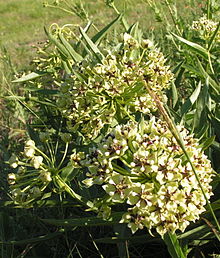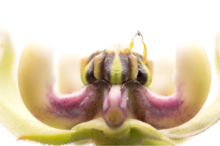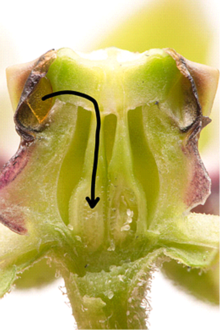
A pollinator is an animal that moves pollen from the male anther of a flower to the female stigma of a flower. This helps to bring about fertilization of the ovules in the flower by the male gametes from the pollen grains.

Asclepias tuberosa, commonly known as butterfly weed, is a species of milkweed native to eastern and southwestern North America. It is commonly known as butterfly weed because of the butterflies that are attracted to the plant by its color and its copious production of nectar.

The monarch butterfly or simply monarch is a milkweed butterfly in the family Nymphalidae. Other common names, depending on region, include milkweed, common tiger, wanderer, and black-veined brown. It is amongst the most familiar of North American butterflies and an iconic pollinator, although it is not an especially effective pollinator of milkweeds. Its wings feature an easily recognizable black, orange, and white pattern, with a wingspan of 8.9–10.2 cm (3.5–4.0 in). A Müllerian mimic, the viceroy butterfly, is similar in color and pattern, but is markedly smaller and has an extra black stripe across each hindwing.
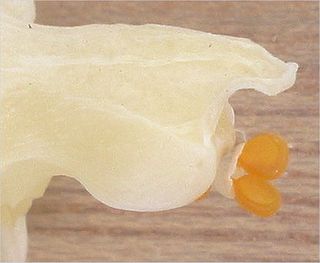
A pollinium is a coherent mass of pollen grains in a plant that are the product of only one anther, but are transferred, during pollination, as a single unit. This is regularly seen in plants such as orchids and many species of milkweeds (Asclepiadoideae). Usage of the term differs: in some orchids two masses of pollen are well attached to one another, but in other orchids there are two halves each of which is sometimes referred to as a pollinium.

Asclepias is a genus of herbaceous, perennial, flowering plants known as milkweeds, named for their latex, a milky substance containing cardiac glycosides termed cardenolides, exuded where cells are damaged. Most species are toxic to humans and many other species, primarily due to the presence of cardenolides. However, as with many such plants, some species feed upon them or from them. The most notable of them is the monarch butterfly, which uses and requires certain milkweeds as host plants for their larvae.

Asclepias syriaca, commonly called common milkweed, butterfly flower, silkweed, silky swallow-wort, and Virginia silkweed, is a species of flowering plant. It is native to southern Canada and much of the United States east of the Rocky Mountains, excluding the drier parts of the prairies. It is in the genus Asclepias, the milkweeds. It grows in sandy soils as well as other kinds of soils in sunny areas.

Asclepias incarnata, the swamp milkweed, rose milkweed, rose milkflower, swamp silkweed, or white Indian hemp, is a herbaceous perennial plant species native to North America. It grows in damp through wet soils and also is cultivated as a garden plant for its flowers, which attract butterflies and other pollinators with nectar. Like most other milkweeds, it has latex containing toxic chemicals, a characteristic that repels insects and other herbivorous animals.
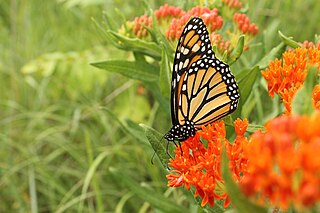
Butterfly gardening is a way to create, improve, and maintain habitat for lepidopterans including butterflies, skippers, and moths. Butterflies have four distinct life stages—egg, larva, chrysalis, and adult. In order to support and sustain butterfly populations, an ideal butterfly garden contains habitat for each life stage.

Asclepias curassavica, commonly known as tropical milkweed, is a flowering plant species of the milkweed genus, Asclepias. It is native to the American tropics and has a pantropical distribution as an introduced species. Other common names include bloodflower or blood flower, cotton bush, hierba de la cucaracha, Mexican butterfly weed, redhead, scarlet milkweed, and wild ipecacuanha.

Asclepias purpurascens, the purple milkweed, is a herbaceous plant species. It is in the genus Asclepias, making it a type of milkweed. It is native to the Eastern, Southern and Midwestern United States similar to the range of the common milkweed. The plant gets its name from the flowers that first develop a pink color but then turn darker purple as they mature. Unlike common milkweed, purple milkweed prefers some shade and is considered a plant of partial shade. It is also considered an indicator of oak savanna, especially in Wisconsin. The species rarely produces seed pods which are smooth, instead of the rough warty ones produced by common milkweed.

Asclepias verticillata, the whorled milkweed, eastern whorled milkweed, or horsetail milkweed, is a species of milkweed native to most of eastern North America and parts of western Canada and the United States.
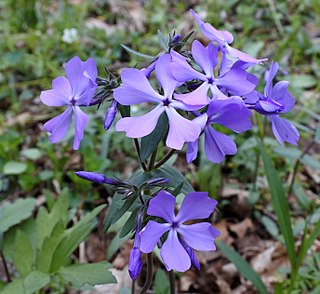
Phlox divaricata, the wild blue phlox, woodland phlox, or wild sweet william, is a species of flowering plant in the family Polemoniaceae, native to forests and fields in eastern North America.

Asclepias speciosa is a milky-sapped perennial plant in the dogbane family (Apocynaceae), known commonly as the showy milkweed and is found in the western half of North America.

Asclepias meadii is a rare species of milkweed known by the common name Mead's milkweed. It is native to the American Midwest, where it was probably once quite widespread in the tallgrass prairie. Today much of the Midwest has been fragmented and claimed for agriculture, and the remaining prairie habitat is degraded.

Asclepias quadrifolia, commonly called four-leaved milkweed or fourleaf milkweed, is a species of milkweed in the Apocynaceae (dogbane) family. It is sometimes referred to as whorled milkweed, but it should not be confused with Asclepias verticillata. A. quadrifolia occurs in the eastern United States and Canada.

Asclepias lanceolata, the fewflower milkweed, is a species of milkweed that is native to the coastal plain of the United States from New Jersey to Florida and Southeast Texas. A. lanceolata is an upright, perennial plant that can grow between 3 and 5 feet tall, with red-orange flowers blooming in the summer months. It can also be referred to as Cedar Hill milkweed, as it was first described by Dr. Eli Ives in the neighborhood of Cedar Hill in New Haven, Connecticut.

Asclepias sullivantii is a species of flowering plant in the milkweed genus, Asclepias. Common names include prairie milkweed, Sullivant's milkweed, and smooth milkweed. It is native to North America, where it occurs in the central United States and Ontario in Canada.

Asclepias curtissii, or Curtiss's milkweed, is a rare species of flowering milkweed that is endemic to Florida's sandy areas. Curtiss's milkweed belongs to the subfamily Asclepiadoideae and the genus Asclepias. This dicotyledonous, perennial plant was placed on the endangered species list by the state of Florida to protect this rare milkweed. Although Curtiss milkweed is found all over Florida, the populations are very isolated and concentrated.

Asclepias angustifolia, commonly called the Arizona milkweed, is an endemic species of milkweed native only to Arizona.

The pollination of orchids is a complex chapter in the biology of this family of plants that are distinguished by the complexity of their flowers and by intricate ecological interactions with their pollinator agents. It has captured the attention of numerous scientists over time, including Charles Darwin, father of the theory of evolution by natural selection. Darwin published in 1862 the first observations of the fundamental role of insects in orchid pollination, in his book The Fertilization of Orchids. Darwin stated that the varied stratagems orchids use to attract their pollinators transcend the imagination of any human being.
